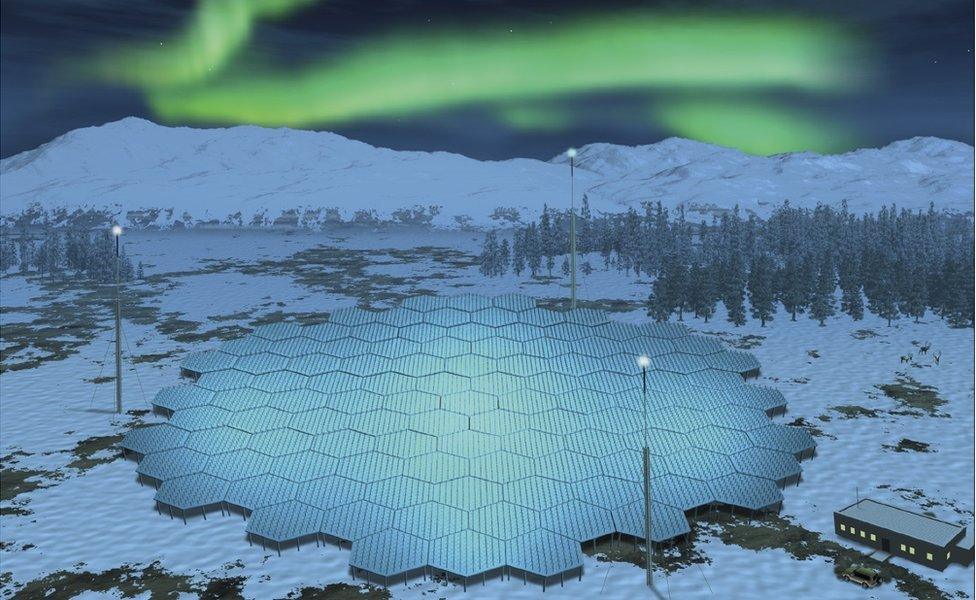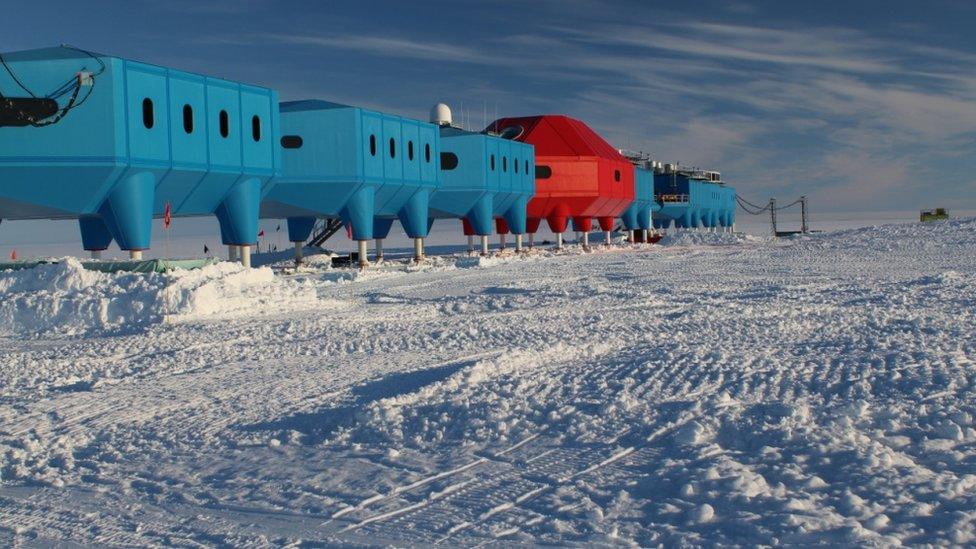Arctic radar to probe 'space weather'
- Published

Artwork of EISCAT_3D: The Northern Lights are a benign consequence of space weather
The UK is to contribute to a sophisticated new radar system in the Arctic to study "space weather".
This phenomenon describes the effects on Earth's wider environment as it is constantly bombarded by particles and magnetic energy from the Sun.
The impacts can damage satellites and even disrupt electricity grids.
The radar, external, to be built across Norway, Sweden and Finland by the European Incoherent Scatter Association (EISCAT), should come online in 2021.
The international organisation already operates radar facilities in the far north, but the new technology is regarded as a big step forward in capability.
"This is the next generation," said Dr Andrew Kavanagh, a EISCAT member scientist working with the British Antarctic Survey (BAS).
"The system will look like a flat field of antennas, much like some of the big radio astronomy telescopes such as LOFAR and SKA. We will be able to do a lot more with this new system - looking at large parts of the sky simultaneously. A 3D view of the sky."

Some of the Sun's eruptions head straight for Earth
Britain is paying £4-6m of the £63m total cost. The participation will give the nation's researchers working in the field of solar-terrestrial physics access to the radar data when it becomes available.
The Sun perpetually billows clouds of magnetic energy and plasma (a gas of electrically charged particles) in all directions. But often great eruptions of this emission are directed straight at Earth.
When these interact with our planet's own magnetic field and atmosphere, they set off all manner of disturbances.
The Aurora Borealis is one such consequence, as particles are accelerated downwards to collide with air molecules to produce colourful curtains of light in high-latitude skies.
But there are more concerning interactions that can lead to upsets in spacecraft electronics, drop-outs in radio communications, and surges in power networks on the ground.
There is even some evidence that the magnetic disturbance from solar storms can confuse the "biological compass" whales use to navigate the oceans resulting in their stranding.
The concerns have led the UK government to put space weather on the National Risk Register, external.
A London Economics analysis, external earlier this year found that losing access to the GPS satellite-navigation service for a period of five days would cost the British economy more than £5bn.

The British Antarctic Survey hopes soon to resume operations at Halley
The new radar system will be set up at Skibotn in Norway, near Kiruna in Sweden, and near Kaaresuvanto in Finland.
Skibotn will have a transmitter and receiver array, while the two other locations will have receiver arrays.
The technology will enable scientists to probe in detail the ionosphere - the region of the Earth's upper-atmosphere that ranges from about 70km to 1,000km in altitude.
It will sample the electron concentration and temperature, and the ion temperature and velocity at various heights along the radar beam direction.
Dr Kavanagh explained: "We will have digital beam-forming and steering, which means in practice that we can generate multiple beams looking in multiple directions, so that we can cover a volume of the sky rather just look at what we like to call a pencil beam."
Some of the interactions can stimulate currents that then heat the high atmosphere. This is a particular interest for some UK scientists.
The heating can alter the density of air molecules at altitudes where low-orbiting satellites move. This perturbs their trajectory ever so slightly. And by the same token, it also changes the path of redundant hardware, or "space junk", speeding up or slowing down the time it takes for this material to fall back to Earth.

Artwork: Space junk poses a collision threat to active satellites
Prof Duncan Wingham is chief executive of the Natural Environment Research Council (Nerc), which holds the UK membership of EISCAT.
He said: "EISCAT_3D will give us a 3D picture of interactions between space weather and our upper atmosphere with a detail we've not seen before, giving us answers to questions researchers have about the impacts of space weather on the upper atmosphere.
"We need this information to reduce the risks posed by space weather on our communications systems, satellites and power grids, which we all rely on."
The British Antarctic Survey does much of its space weather research at the other end of the globe, at its polar bases Rothera and Halley.
The latter was recently evacuated because of developing cracks in the ice platform on which it sits. This meant Halley's space weather instruments had to be turned off, breaking their data contribution to the forecasting models produced by scientists.
Dr Kavanagh said BAS hoped to get this equipment back up and running soon, adding that there was a plan for the future which would allow instruments to be operated remotely should Halley have to shut down again.
Jonathan.Amos-INTERNET@bbc.co.uk, external and follow me on Twitter: @BBCAmos, external
- Published7 June 2017

- Published16 January 2017
